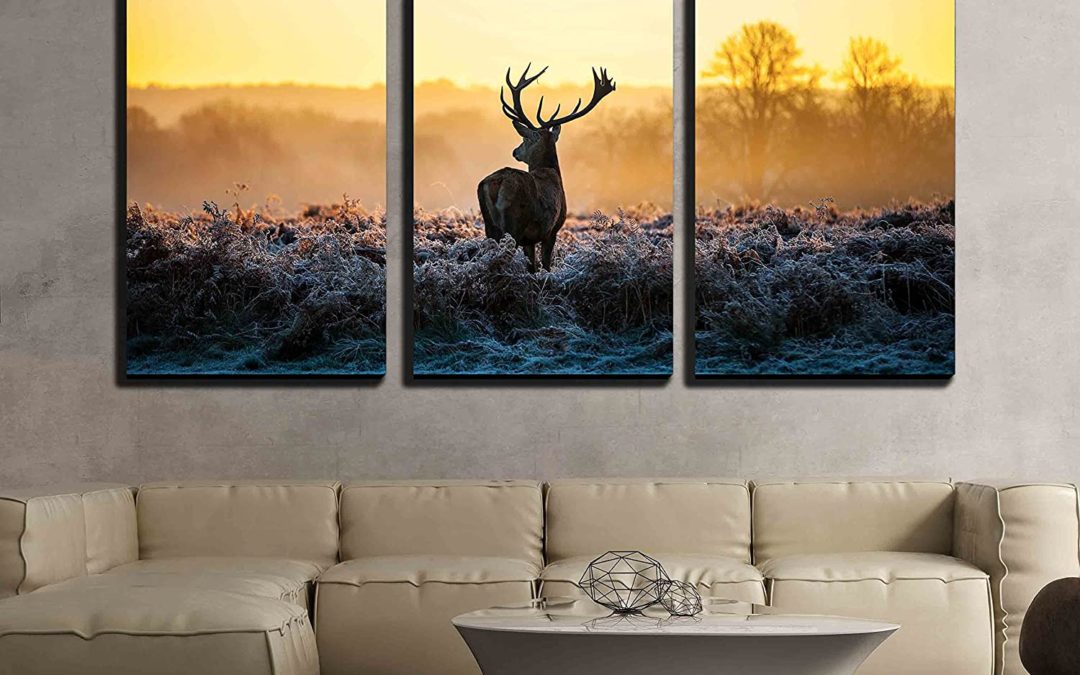Deer are among the most recognizable types of animals on Earth. A type of mammal from the “ungulate” family, or four legged creatures with hooves, deer have a strong presence in daily life and popular culture. Though often depicted in media as gentle and good natured, the reality is that deer are often negatively perceived. They are well known for their fondness for feeding on garden plants and running onto roads, much to the annoyance of humans. That said, it’s important to learn about our four-legged, horned neighbors. Read below for some deer wall art facts.
American History
There are deer that are native to nearly every continent in the world. In North America, our native deer is the white-tailed variety. White-tailed deer have played a very important role in the early history of the United States. A valuable resource for both lean meat and warm clothing, deer were used extensively by Native Americans, settlers from Europe, and eventually the colonists. The combined white-tailed deer popularity and American deforestation resulted in the deer population decreasing significantly by the 1800s. Over the past several decades, however, the white-tailed deer population has grown significantly due to new laws and environmental volunteer work. Read below for the next deer wall art fact.
Hearing
Thanks to evolution, the deer’s sense of hearing is finely attuned to detect even the faintest of sounds. Ever tried hunting a deer? If you have, you’d known that their sense make it so that they are always alert. Even the snap of a tree branch from yards away can send them running off to a safe place to hide. That said, it can be easy to trick a deer. Oftentimes, they don’t only rely on their ears to sense danger. They may here something suspicious, but if they don’t smell anything or see any movement they may just ignore whatever they heard. Read below for the next deer wall art fact.
Diet
Deer are herbivores. In other words, they only eat vegetables, plants and fruits. Deer are known for preferring very tender and chewable vegetation; they don’t like to work hard for what they eat, so they dine in a way that expends as little energy as possible. Although they have a preference for softer vegetation, they will eat any texture or type of plant if they can’t find anything better. During the spring and summer, deer tend to feet on leafy greens, flower buds, and different types of seasonal growth. During the fall, deer feed on corn and various types of wild nuts. During the winter, deer mostly feed off of thick tree wood and coarse shrubbery. Read below for the next deer wall art fact.
Smell
Deer have heightened senses in order to avoid danger. Did you know that a deer’s nose is one of their most important body parts. Their nose is very comparable to that of a dog’s. Wet and sensitive to the touch, deer noses function much like their ears do in regard to sensing dangers. Foreign particles from organisms or objects that do not usually enter the forest float around, until they latch onto the deer’s nose. The deer’s olfactory centers then transmit the scent of the particles to the deer’s brain, alerting them of unnatural or unusual scents that they should probably run away from. Read below for the next deer wall art fact.
Habitat
As previously mentioned, deer are often derided due to their close proximity to residential environments. Have you ever driven on a road, narrowly missing a running deer? Has there ever been a time where you’ve gone outside to get the morning paper, only to see a deer feeding on your peonies? If you have, that’s very common! Why, you ask? Deer like to live in a habitat called a “transitional” environment. A transitional environment is an area where forest and open land are connected. Forest land provides shelter, while open lands gives deer opportunity to find places to forage for food when the forest is light on nutrition. Did you enjoy these deer wall art facts?
Conclusion
If you’re like us, you probably feel two ways about deer. You can acknowledge their beauty and utility in terms of providing both food and fur. You also understand how annoying they can be due to their encroaching presence on residential environments. Like most things in life, deer have both good and bad qualities. It’s important to remember that no matter what we think, deer are still valuable parts of nature and modern living. We hope you enjoyed these deer wall art facts!





